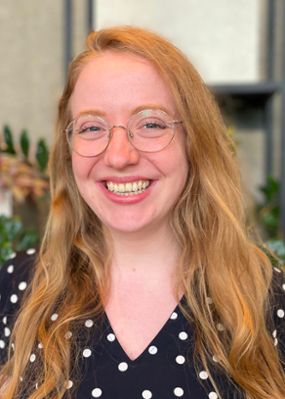Physics graduate student receives prestigious DOE grant
Michigan State University graduate student Hannah Christine Berg is the recipient of a highly competitive Department of Energy (DOE) Office of Science Graduate Student Research Program (SCGSR) grant.
Berg is one of 80 outstanding graduate students representing 27 states in the program, each of whom was selected through peer review by external scientific experts. Awards for this cohort were made through the SCGSR program’s second of two annual solicitation cycles for FY 2021.

Berg, a Ph.D. student in nuclear astrophysics working at the Facility for Rare Isotope Beams, or FRIB, plans to conduct her research on using low-energy beams from Argonne National Laboratory's CAlifornium Rare Isotope Breeder Upgrade (CARIBU) to constrain neutron-capture reactions of importance to the i-process at the Lawrence Livermore National Laboratory (LLNL) in California. Her collaborating DOE researcher will be Darren Bleuel, a scientist at LLNL with a background in experimental nuclear physics.
“I am honored to be awarded this opportunity to do research at Lawrence Livermore National Lab,” Berg said. "I look forward to working with the local experts and expanding my knowledge in the field at LLNL, where I will be working specifically to combine indirect measurement methods for neutron-capture processes, which is important to understand how elements are produced in stars.
Berg’s project involves measuring the ß-decay of 152-154Pr into 152-154Nd and applying the ß-Oslo method to extract the nuclear level density and ?-ray strength function of 152-154Nd. Interestingly, the ß-Oslo method was developed at MSU/NSCL by MSU Department of Chemistry professor, Sean Liddick, and nuclear physicist, Artemis Spyrou, professor at FRIB and in the Department of Physics & Astronomy in the College of Natural Science, among others. This research can help explain how elements heavier than iron are made in stars.
“I’m very happy and proud that Hannah received this fellowship from the DOE,” Spyrou said. “This is a great opportunity for her to explore new research directions, and to expand her knowledge working with a group of experts at Lawrence Livermore National Lab. Hannah’s dedication and drive are exemplary and she is highly deserving of this honor.”
Additionally, Berg’s research involves expanding upon data analysis processes and teaching these processes to other students and researchers. She will not only be utilizing the current Oslo techniques for her experiments but also implementing co-analysis with the surrogate method where data for both experiments is available to better constrain neutron-capture cross sections relevant to neutron-rich nucleosynthesis.
SCGSR awardees receive world-class training through access to state-of-the-art facilities and resources at DOE national laboratories, which allow them to conduct research on projects of significant importance to the Office of Science mission that address societal challenges at national and international scales—and help secure the U.S. position at the forefront of discovery and innovation.
Projects span the eight Office of Science research programs: advanced scientific computing research, biological and environmental research, basic energy sciences, fusion energy sciences, high energy physics, nuclear physics, accelerator R&D and production, and isotope R&D and production as well as four additional priority convergence research topical areas: microelectronics, data science, conservation laws and symmetries, and accelerator science.
For a complete list of this cohort of SCGSR awardees, visit https://www.energy.gov/science/articles/does-office-science-graduate-student-research-scgsr-program-selects-80-outstanding.
Banner image: The SuN (Summing NaI) detector used by Berg’s research group at FRIB to measure neutron-capture cross sections indirectly. These measurements are needed in nuclear astrophysics to understand how elements are made. Credit: FRIB